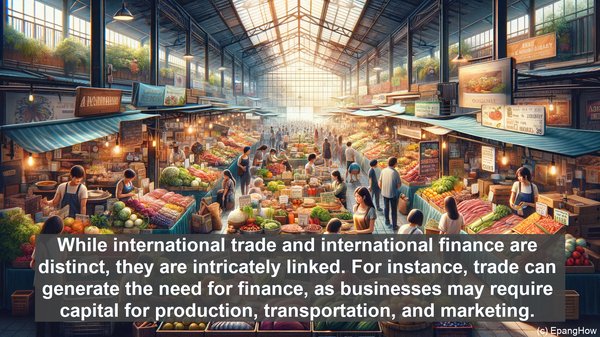Introduction: The Interplay of Trade and Finance
Hello everyone! Welcome to this insightful article on the distinction between international trade and international finance in economics. While both these aspects are integral to the functioning of the global economy, they address different dimensions. Let’s dive deeper into their nuances.
International Trade: Facilitating Global Exchange
International trade refers to the exchange of goods and services across national borders. It encompasses imports (goods and services brought into a country) and exports (goods and services sent out of a country). Trade plays a pivotal role in fostering economic growth, as it allows nations to specialize in the production of goods and services they have a comparative advantage in. This, in turn, leads to increased efficiency and higher overall output.
Key Aspects of International Trade
Several factors shape the dynamics of international trade. One such factor is trade barriers, which can be in the form of tariffs (taxes on imports) or quotas (limits on the quantity of imports). These barriers can influence the volume and pattern of trade between countries. Additionally, trade agreements, such as free trade agreements, aim to reduce or eliminate trade barriers, thereby promoting greater economic integration. Another critical aspect is the balance of trade, which refers to the difference between a country’s exports and imports. A trade surplus occurs when exports exceed imports, while a trade deficit arises when imports surpass exports.
International Finance: Managing Capital Flows
International finance, on the other hand, deals with the movement of capital across borders. It encompasses various financial transactions, including foreign direct investment (FDI), portfolio investment, and borrowing and lending between nations. The primary objective of international finance is to facilitate the efficient allocation of capital globally. It enables countries to access funds for development projects, supports businesses in their expansion endeavors, and provides individuals with investment opportunities beyond their domestic markets.

Crucial Elements of International Finance
Exchange rates play a central role in international finance. They determine the value of one currency in relation to another, impacting the cost of goods and services in international markets. Exchange rates can be fixed, where they are set by the government, or floating, where they are determined by market forces. Another key aspect is the balance of payments, which records all economic transactions between a country and the rest of the world. It consists of the current account (trade in goods and services), capital account (financial transactions), and the reserve account (changes in foreign exchange reserves).

Interconnectedness: Trade-Finance Nexus
While international trade and international finance are distinct, they are intricately linked. For instance, trade can generate the need for finance, as businesses may require capital for production, transportation, and marketing. On the other hand, finance can influence trade, as the availability and cost of capital can impact a country’s competitiveness in the global market. Moreover, exchange rate fluctuations can have implications for both trade and finance, affecting the relative prices of goods and the returns on investments.
